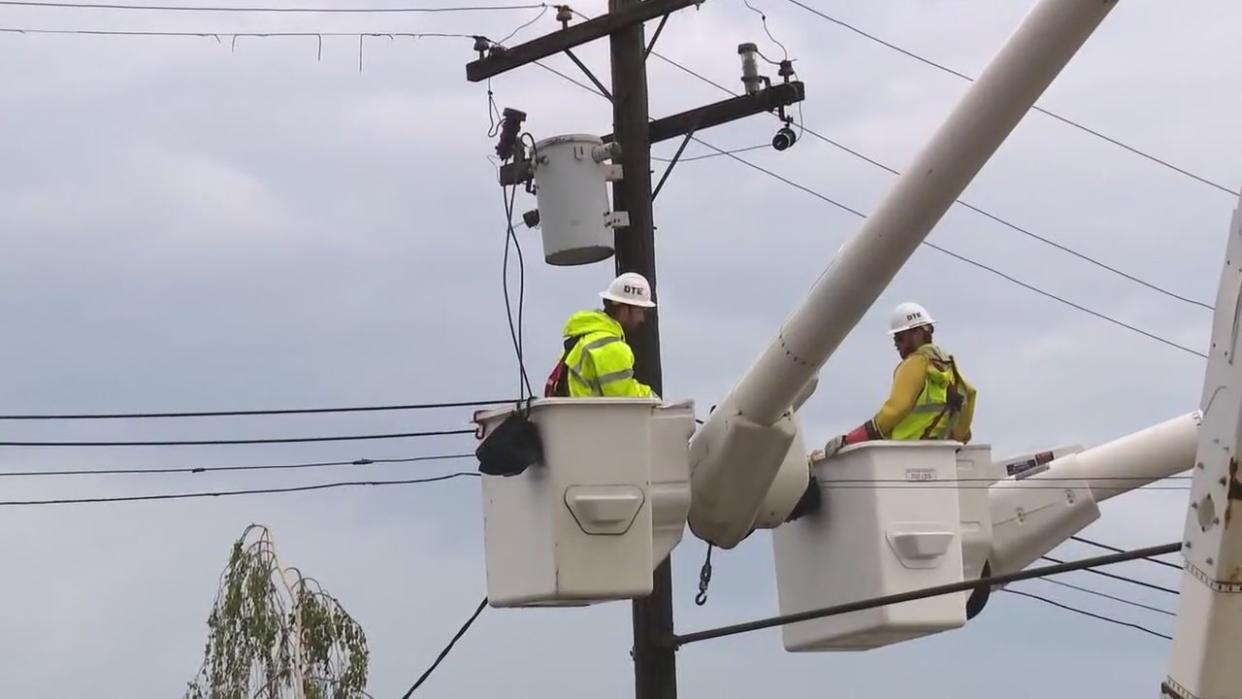DTE Energy credits after this week's storm: Who qualifies

The final week of summer is going out with a bang – literally for a few hundred thousand in Southeast Michigan – and DTE Energey customers may be eligible for a credit.
This week, more than 204,000 DTE customers were in the dark after a severe round of thunderstorms and strong winds knocked out power throughout Southeast Michigan.
Two days later, roughly 74,000 customers are still without power as the company is moving to try to restore power as fast as possible.
The utility companies have hundreds of crews in the field, including DTE lineman teams from out of state, as they restore power. At one point after the storm, more than 300,000 customers were in the dark.
"We have an unprecedented number of line workers in the field making repairs -- thousands of DTE employees as well as 1,500 line workers from as far away as New York, North Carolina, Georgia and Tennessee," said Brian Calka, vice president, Distribution Operations. "We’ve brought in more crews than ever before to support restoration because we know how important it is to safely and quickly bring the lights back on for our customers."
How to get a DTE credit
When the power is out for an extended period of time that's caused by an event like severe weather, DTE offers bill credits of $38. But there are a few things to know before you find out if. you qualify.
DTE offers credits based on either having an extended outage or a frequent outage. An extended outage is one of these three:
A power outage of more than 16 hours affecting 1% or fewer customers
A power outage of more than 48 hours affecting between 1% and 10% of customers
A power outage of 96 hours under catastrophic conditions – an official state of emergency is declared – or an event that affects 10% or more DTE customers.
If your outage qualifies, you'll receive an additional credit for every 24 hours without power.
A frequent outage is six outages during a 12-month span.
DTE will determine who is eligible and then post the credit to the account the next two billing cycles – or up to 90 days after the outage.
You do not need to apply for the credit.
Is your food still good?
If you've been without power for an extended period of time, you may be on the edge of tossing everything out.
There are two figures to keep in mind when the power goes out and you're assessing whether to keep your food: 4 hours and 48 hours.
If the doors remain closed, the refrigerator will keep food cold for about 4 hours. If a freezer is full, it will keep the temperature cool enough for approximately 48 hours. It'll stay cold for only about 24 hours if it's half full.
The Food and Drug Administration says adding a block of dry ice can keep a fully stocked refrigerator cold for two days.
What to eat when the power goes out
Your best friend during a power outage is the pantry since nonperishable foods can withstand months of waiting without going bad.
Things like peanut butter, breakfast cereal, as well as canned fruits and vegetables that are low in sodium. Nuts, crackers, snack bars. Grains, beans, and overnight oats that mix with water the night before can also be good sources of energy and don't require preparation or refrigeration before consumption.
If power is restored before the temperatures get too high, meals that include meat, poultry, fish, or eggs, should be thoroughly cooked to a safe internal temperature. That way, foodborne bacteria that may have grown can be destroyed.
But if at any point the food was sitting above 40 degrees Fahrenheit in the refrigerator for more than two hours, it should be thrown out.
Tips to keep food cooler for longer
It'll require some preparation, but in times of an emergency, having food stay cooler for longer can go a long way.
One of the best ways is to freeze some refrigerated items, like leftover milk and meat.
Grouping food together can also go a long way in retaining more cold temperatures in both the freezer and refrigerator.
Having coolers with ice available can also help. That means having gel ice packs or bags of ice on hand.
Dry ice or block ice can also keep things cooler for longer.






